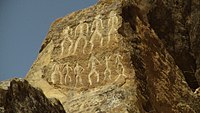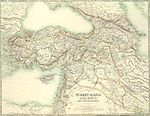Aq Qoyunlu
White Sheep Ak Koyunlu Akgoýunly | |||||||
|---|---|---|---|---|---|---|---|
| 1378–1508 | |||||||
|
Flag of Ak Koyunlu | |||||||
 The Ak Koyunlu Confederation in 1478 | |||||||
| Capital | Tabriz (after 1468) | ||||||
| Common languages | Oghuz | ||||||
| Religion | Shi'ite | ||||||
| Government | Monarchy | ||||||
| Ruler | |||||||
• 1378-1435 | Kara Yülük Osman | ||||||
• 1501-1508 | Murad ibn Ya‘qub | ||||||
| Historical era | Medieval | ||||||
• Established | 1378 | ||||||
• Disestablished | 1508 | ||||||
| |||||||
 |
| History of Greater Iran |
|---|
The Ak Koyunlu or Aq Qoyunlu, also called the White Sheep Turkomans (Turkmen: Akgoýunly / آق قویونلو, Azeri: آق قویونلو or آغ قویونلو / Ağqoyunlu, Turkish: Akkoyunlu, Ottoman Turkish: آق قوینلو, [ آغ قویونلو or آق قوینلو ] Error: {{Lang-xx}}: text has italic markup (help)), was an Oghuz Turkic tribal federation, that ruled parts of present-day Eastern Turkey, Armenia, Azerbaijan, northern Iraq, and western Iran from 1378 to 1508.
History
According to Byzantine chronicles, the Ak Koyunlu were present in eastern Anatolia since at least 1340, and most of their leaders, including the dynasty's founder, Uzun Hassan[1], married Byzantine princesses [2].
Ak Koyunlu Turkomans first acquired land in 1402, when Tamerlane granted them all of Diyarbakır, in present-day Turkey. For a long time, the Ak Koyunlu were unable to expand their territory, as the rival Kara Koyunlu kept them at bay. However, this changed with the rule of Uzun Hassan who defeated the Black Sheep Turkoman leader, Jahān Shāh, in 1467.
After the defeat of a Timurid leader, Abu Sai'd, Uzun Hassan was able to take Baghdad, along with territories around the Persian Gulf. He expanded into Iran as far east as Khorasan. However, around this time, the Ottoman Empire sought to expand eastwards, a serious threat that forced the Ak Koyunlu into an alliance with the Qaramanids of central Anatolia.
As early as 1464, Uzun Hassan had requested military aid from one of the Ottoman Empire's strongest enemies, Venice, however, despite Venetian promises, this aid never arrived, and as a result, Uzun Hassan was defeated by the Ottomans at Tercan in 1473, though this did not destroy the Ak Koyunlus. When Uzun Hassan died early in 1478, he was succeeded by his son Khalil Mirza (Sultan Khalil), but he was defeated by a confederation under his younger brother Ya'qub at the Battle of Khoy in July.[3]
Ya'qub, who reigned from 1478 to 1490, sustained the dynasty for a while longer. However, during the first four years of his reign there were seven pretenders to the throne that had to be put down.[4] Following Ya'qub's death civl war again erupted, the Ak Koyunlus destroyed themselves from within, and they ceased to be a threat to their neighbours.
The Safavids, who were Shi'ites, began to undermine the allegiance of many Ak Koyunlu , particularly Sunnis. The Safavids and the Ak Koyunlu met in battle at Nakhichevan in 1501, and the Safavid leader Ismail I forced the Ak Koyunlu to withdraw.
In his retreat from the Safavids, the Ak Koyunlu leader Alwand destroyed an autonomous Ak Koyunlu state in Mardin. The last Ak Koyunlu leader, Murād, brother of Alwand, was also defeated by the same Safavid leader. Though Murād briefly established himself in Baghdad in 1508, he soon withdrew back to Diyar Bakr, signalling the end of the Ak Koyunlu rule.
Governance
The leaders of Ak Koyunlu were from the Begundur or Bayandur Oghuz clan[5] and were considered descendants of the semi-mythical founding father of the Oghuz, Oghuz Khan[6]. The Bayandurs behaved like statesmen rather than warlords and gained the support of the merchant and feudal classes of South Caucasus (present day Republic of Azerbaijan)[6].
With the conquest of Iran, not only did the Ak Koyunlu center of power shift eastward, but Iranian influences were soon brought to bear on their method of government and their culture [7]. In the Iranian provinces, Uzun Hassan maintained the preexisting administrative system along with its officials, whose families had in some cases served under different dynasties for several generations[8]. There were only four top civil posts, all held by Iranians, in Uzun Hassan's time: those of the vizier, who headed the great council (divan); the mostawfi al-mamalek, who was in charge of the financial administration; the mohrdar, who affixed the state seal, and the marakoor (stablemaster), who looked after the royal court[7].
| History of Azerbaijan |
|---|
 |
|
|
In letters from the Ottomon Sultans, when addressing the kings of Ak koyunlu, such titles as Malak al-Molook al-Iraniyyah (King of Kings of Iran), Sultan Salatin Iraniyyah(Sultan of Sultans of Iran), Shahanshah Iran Khadiv ajam (King of Kings of Iran and the Ruler of Persia), Jamshid Shawkat wa Fereydoon Raayat wa daaraa deraayat (Powerful like Jamshid, Flag of Fereydoon and Wise like Darius) have been used[9]. Uzun Hassan also held the title "Padishah-i-Iran"(King-ruler of Iran)[10], which was re-adopted again in the Safavid times through his grandson Ismail I, the founder of the Safavid dynasty.
Ahmad-beg Ak Koyunlu
Amidst the struggle for power between Uzun Hassan's grandsons Baysungur (son of Yaqub) and Rustam (son of Maqsud), their cousin Ahmad-beg appeared on the stage. Ahmad-beg was the son of Uzun Hassan's eldest son Oghurlu Muhammad, who, in 1475, escaped to Ottoman Turkey. Ottoman Sultan Mehmed II received Oghurlu Muhammad with kindness and gave him his daughter, of whom Ahmad-beg was born[11].
According Hasan Rumlu's Ahsan al-tavarikh, in 1496-7 certain Hasan Ali Tarkhani went to Ottoman Turkey to tell Sultan Beyazid II that Azerbaijan and Persian Iraq were defenceless and suggested that Ahmad-beg, heir to that kingdom, should be sent there with Ottoman troops. Beyazid II agreed to this idea, and by May 1497 Ahmad-beg faced Rustam near Araxes and defeated him [11].
See also
Sources
- Bosworth, Clifford. The New Islamic Dynasties, 1996.
- Morby, John. Oxford Dynasties of the World, 2002.
References
- ^ Minorsky, Vladimir (1955). "The Aq-qoyunlu and Land Reforms (Turkmenica, 11)". Bulletin of the School of Oriental and African Studies, University of London. 17 (3): 449.
{{cite journal}}: Cite has empty unknown parameters:|month=and|coauthors=(help) - ^ Robert MacHenry. The New Encyclopedia Britannica, Encyclopaedia Britannica, 1993, ISBN 0852295715, p. 184
- ^ Woods, John E. (1999) The Aqquyunlu: Clan, Confederation, Empire University of Utah Press, Salt Lake City, p. 128, ISBN 0-87480-565-1
- ^ Woods, John E. (1999) The Aqquyunlu: Clan, Confederation, Empire University of Utah Press, Salt Lake City, p. 125, ISBN 0-87480-565-1
- ^ C.E. Bosworth and R. Bulliet. The New Islamic Dynasties: A Chronological and Genealogical Manual , Columbia University Press, 1996, ISBN 0231107145, p. 275
- ^ a b Charles van der Leeuw. Azerbaijan: A Quest of Identity, a Short History, Palgrave Macmillan, ISBN 0312219032, p. 81
- ^ a b Encyclopedia Iranica. "Akkoyunlu" by Rosemarie Quiring-Zoche
- ^ Jean Aubin. "Etudes Safavides: Shah Ismail I et les notables de l'Iraq Persan", JESHO 2, 1959, pp. 37-81
- ^ Seyyed Ali Mua’yyad Sabeti, “Asnaad o Naameh-aayeh Tarikhi az Avael Dorrehaayeh Eslali taa Avakher ‘Ahd Shah Ismail Safavi”(historical sources and letters from the beginning of the Islamic era till the end of the era of Shah Ismail Safavi), Tehran , Ketabkhaayeh Tahoori, 1366. pages 193, 274, 315, 330, 332, 422 and 430. See also: Abdul Hussein Navai, Asnaad o Mokatebaat Tarikhi Iran (Historical sources and letters of Iran), Tehran , Bongaah Tarjomeh and Nashr-e-Ketab, 2536, pages 578,657, 701-702 and 707
- ^ H.R. Roemer, The Safavid Period, in Cambridge History of Iran, Vol. VI, Cambridge University Press 1986, p. 339:Further evidence of a desire to follow in the line of Turkmen rulers is Ismail's assumption of the title "Padishah-i-Iran", previously held by Uzun Hasan
- ^ a b Vladimir Minorsky. "The Aq-qoyunlu and Land Reforms (Turkmenica, 11)", Bulletin of the School of Oriental and African Studies, University of London, Vol. 17, No. 3. (1955), p. 458
| History of Turkey |
|---|
 |
| Timeline |
|
|

